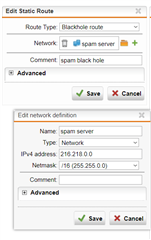Hello Sophos friends,
I have trivial problem but I can't figure why is that happening. On our UTM SG330 box, I want to block all the possible communication to particular IP (in the internet)
Let's say we have bunch of users (in internal network) potentially communicating with that IP. The users are using the UTM as proxy. I have added the IP address to unwanted websites and I have set up that this IP address is malicious from proxy's point of view (category - Illegal software, characteristics - malicious web).
I have also created a firewall rule dropping any protocol going to that destination IP adderss from all the IPv4 and IPv6 addresses.
How come I can still do -> C:\telnet.exe a.b.c.d 443 and it goes through? a.b.c.d is the destination address I don't want to communicate with under any circumnstances.
Many thanks in advance.
ZS
This thread was automatically locked due to age.



